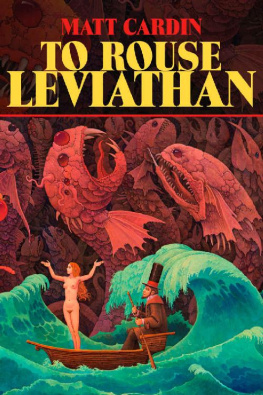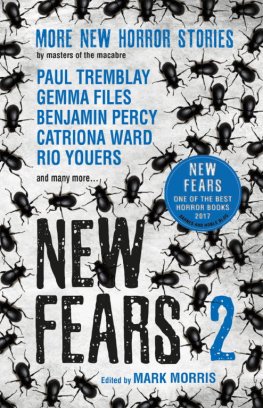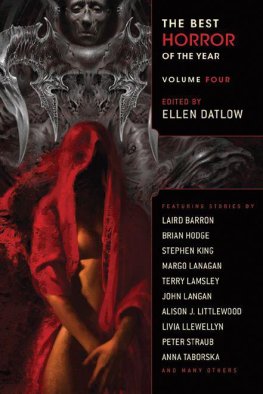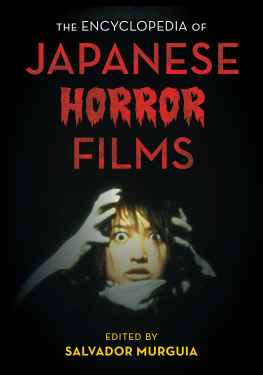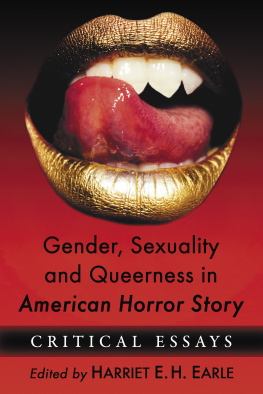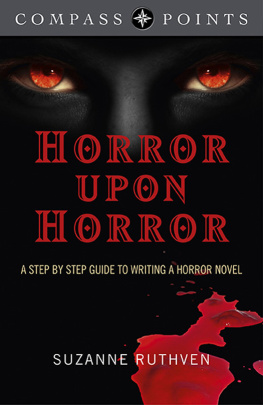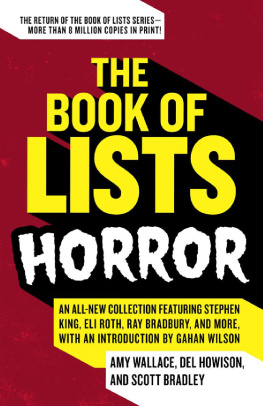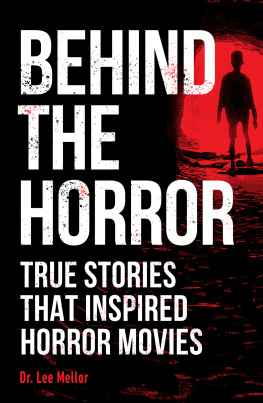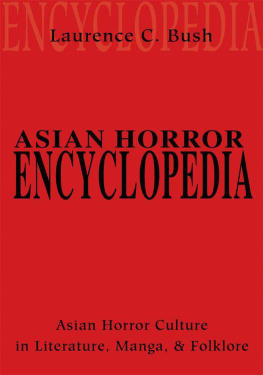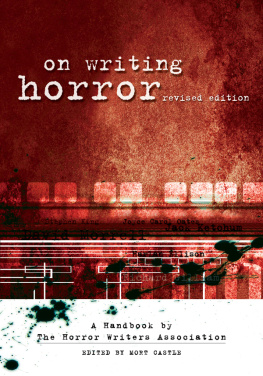Horror Literature
through History
Horror Literature
through History
An Encyclopedia of the Stories
That Speak to Our Deepest Fears
VOLUME 1
MATT CARDIN, EDITOR

Copyright 2017 by ABC-CLIO, LLC
All rights reserved. No part of this publication may be reproduced, stored in a retrieval system, or transmitted, in any form or by any means, electronic, mechanical, photocopying, recording, or otherwise, except for the inclusion of brief quotations in a review, without prior permission in writing from the publisher.
Library of Congress Cataloging-in-Publication Data
Names: Cardin, Matt, editor.
Title: Horror literature through history : an encyclopedia of the stories that speak to our deepest fears / Matt Cardin, editor.
Description: Santa Barbara, California : Greenwood, 2017. |
Includes bibliographical references and index.
Identifiers: LCCN 2017000044 (print) | LCCN 2017000211 (ebook) |
ISBN 9781440842016 (set : acid-free paper) | ISBN 9781440847561
(volume 1 : acid-free paper) | ISBN 9781440847578 (volume 2 : acid-free
paper) | ISBN 9781440842023 (ebook)
Subjects: LCSH: Horror talesHistory and criticismEncyclopedias.
Classification: LCC PN3435 .H665 2017 (print) | LCC PN3435 (ebook) |
DDC 809.3/8738dc23
LC record available at https://lccn.loc.gov/2017000044
ISBN: 978-1-4408-4201-6 (set)
978-1-4408-4756-1 (vol. 1)
978-1-4408-4757-8 (vol. 2)
978-1-4408-4202-3 (ebook)
21 20 19 18 17 1 2 3 4 5
This book is also available as an eBook.
Greenwood
An Imprint of ABC-CLIO, LLC
ABC-CLIO, LLC
130 Cremona Drive, P.O. Box 1911
Santa Barbara, California 93116-1911
www.abc-clio.com
This book is printed on acid-free paper 
Manufactured in the United States of America
Contents
Guide to Related Topics
Interviews
Horror Literature through History
Horror Types and Subgenres
Monsters, Creatures, Threats, and Villains
Topical Studies
Tropes, Themes, and Narrative Techniques
Authors and Works
Preface
Horror is not only one of the most popular types of literature but one of the oldest. People have always been mesmerized by stories that speak to their deepest fears. Horror Literature through History, in both the scope of its coverage and the currency of its contents, is uniquely suited to speak to this primal and perennial fascination.
It is also a pointedly timely work, as it arrives at a cultural moment when horror is experiencing a fierce resurgence after having gone through a relative cultural downswing during the previous decade. It was not that horror had ever actually died, for it is, as many have enjoyed noting, an undyingor perhaps undeadform of art and entertainment. But it had become somewhat sluggish in the mid- and late 1990s, aided by the flaming out of the great horror publishing boom of the previous decade-plus, whose high-water mark on the mass market end was represented by the soaring popularity of novels by the likes of Stephen King, Peter Straub, Anne Rice, Ramsey Campbell, and Dean Koontz. And so the revival of the early 2000s constitutes a distinct and discernable phenomenon.
Significantly, this revitalization of horror has not been just a literary matter; in this new era, horrors chief audience and consumer base, consisting largely of high schoolaged and college-aged young people, has begun eagerly absorbing horror, especially of the supernatural variety, from a variety of sources. Along with novels and short fiction collections, there are television programs, movies, comic books, and video (and other types of) games. Weird horror fictiona form to be defined and discussed in the pages to followhas entered what some began to call a new golden age, not just in literary form but in film and television, as in HBOs True Detective, whose first season in 2014 displayed the distinct influence of such authors as Robert W. Chambers, Thomas Ligotti, and Laird Barron. Horror gaminglike other gaminghas rapidly attained new heights of technological and narrative sophistication. Horror movie subgenres both old (such as exorcism) and new (such as torture porn and the found-footage world of movies like Paranormal Activity) have become enormously popular and profitable. Armies of zombies have begun to infest the pages of comic books and the proliferating sea of screens both large and small.
And throughout it all, the various nonliterary forms continue to draw deeply on their literary cousins for their basic plots, themes, and ideas. This was always true of horror films, but it is critically important to recognize that it remains equally true during the present era of exploding new forms and media, when it might be possible for a partaker of these new formsthe horror video games, the creepypastas, and so onto ignore or forget the literary foundations of the whole phenomenon. Literary horror predates all of the other types. It has a vastly longer, and therefore richer and deeper, history. And this is where and why a reference work like the present one comes in: because it serves to illuminate the roots of modern horror, both literary and otherwise, by laying out the fields deep history and evolutionary development.
To this end, Horror Literature through History is presented in a three-part structure that is designed for maximum usefulness in assisting all kinds of readers, including those who seek a comprehensive overview of horrors rich literary heritage and those who want to conduct a focused study of specific authors, works, and/or topics. It is also well suited to piecemeal browsing.
, titled Horror through History, consists of eight essays presenting a comprehensive chronological overview of horror literature during different historical periods. These essays take the form of narrative and critical surveys that situate literary works within the social, cultural, historical, and intellectual currents of their respective eras, creating a seamless narrative of the genres evolution from ancient times to the present
, Themes, Topics, and Genres, contains twenty-three essays that show how otherwise unrelated works of horror have influenced each other, how horror subgenres have evolved, and how a broad range of topics within horrorsuch as ghosts, vampires, religion, and gender roles, as well as the academic study of these thingshave been handled across time.
, Reference Entries, presents nearly 400 alphabetically arranged reference entries on authors, works, and specialized topics. It serves as both a source of stand-alone reference reading in its own right and, importantly, a supplement to the encyclopedias preceding sections. In effect, many of the reference entries serve as close-ups on information and concepts presented in the preceding two sections, allowing readers to understand specific authors, works, and topics within the wider context of horror literatures evolutionary history and thematic universe.
Supplementing the main entries are seven original interviews with important contemporary horror authors and editors plus nearly 150 sidebars featuring mini-analyses of literary works, excerpts from primary and secondary works, excerpts from reviews, timelines, trivia, information about media adaptations, and more.
With this unique structure, Horror Literature through History offers a variety of uses both to students and to general readers:
The excerpts from horror novels and stories exemplify topics discussed in the entries, such as theme, language, and characterization. Students are thus able to read these excerpts critically in light of the entries. This supports Common Core State Standards for English language arts.
Next page
![Matt Cardin Horror Literature Through History [2 Volumes]: An Encyclopedia of the Stories That Speak to Our Deepest Fears](/uploads/posts/book/119545/thumbs/matt-cardin-horror-literature-through-history-2.jpg)
